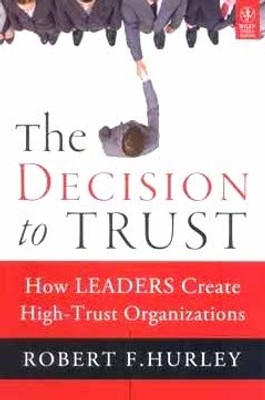The Decision to Trust: How Leaders Create High-Trust Organizations(English, Hardcover, Robert F. Hurley)
Quick Overview
Product Price Comparison
Over the past four decades there has been an unprecedented decline in trust in this country. Today, only a third of Americans believe they can trust the government, big business and large institutions. Few people trust the people they work for and relatively few trust their fellow citizens. The epidemic of distrust is also a global phenomenon: data from the wealthier countries shows a similar decline in how people trust one another--and especially in how much trust they have in their managers and in the organizations they work for. In THE DECISION TO TRUST, Robert Hurley argues that if we allow trust to erode, we stand to lose much of what makes our culture--and our companies--great. He explains how this new culture of cynicism and distrust creates many problems, not the least of which is that it is almost impossible to manage an organization well if the people in it do not trust one another. High performing, world-class companies are almost always high-trust environments--and trust is a key ingredient in their success. Without this elusive and important ingredient, companies cannot attract top talent--or, if they do, the best workers will not stay for very long. Over the past two decades, Hurley has been systematically studying trust from a psychological and a business perspective. In this book, Hurley reveals a new model to measure trust and to repair it, in relationships with colleagues, managers and employees. The model is based on ten factors that establish whether or not one party will trust the other: Risk Tolerance Adjustment Power Situational Security Similarities Interests Benevolent Concern Capability Predictability/Integrity Communication Using detailed case studies--from PriceWaterhouse Coopers to Goldman Sachs, Arthur Andersen and Zappos--Hurley shows how an organization can change its entire culture from one of suspicion to one of trust and inclusion--and dramatically improve the bottom line. He showsbusiness leaders, policy-makers, managers, and engaged citizens how they can use his model to create high-trust organizations, and leverage that trust to attract new talent as well as energize and nurture the creativity and excellence already within their own organization. About the Author Robert F. Hurley (Ridgefield, CT and New York, NY) is Professor at Fordham University and President of Hurley Associates, a consulting firm that uses behavioral science to enhance individual and organizational effectiveness. He is also a core faculty member in the Leading and Managing People Program at Columbia Business School. His work has appeared inHarvard Business Review, California Management Review, among other publications. Table of Contents Introduction 1 The Decision to Trust 2 The Decision to Trust Model 3 How We Differ in Trusting 4 Situational Factors in the Building of Trust 5 Tools for Diagnosing, Building, and Repairing Trust 6 Trust in Leadership and Management 7 Trust in Organizations 8 Building Trust Within Teams 9 Building Trust Across Groups and National Cultures 10 Hope for the Future of Trust Appendix A--Research on the Antecedents to Trust Appendix B--Trust Diagnosis Worksheet Appendix C--Trust Interventions Appendix D--Systemic Trust Interventions Notes Acknowledgments About the Author Index


